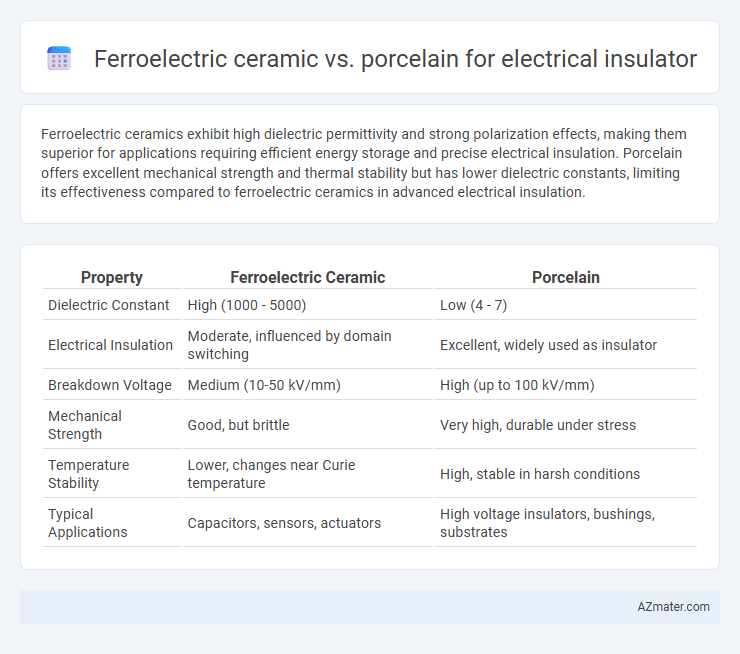Ferroelectric ceramics exhibit high dielectric permittivity and strong polarization effects, making them superior for applications requiring efficient energy storage and precise electrical insulation. Porcelain offers excellent mechanical strength and thermal stability but has lower dielectric constants, limiting its effectiveness compared to ferroelectric ceramics in advanced electrical insulation.
Table of Comparison
| Property | Ferroelectric Ceramic | Porcelain |
|---|---|---|
| Dielectric Constant | High (1000 - 5000) | Low (4 - 7) |
| Electrical Insulation | Moderate, influenced by domain switching | Excellent, widely used as insulator |
| Breakdown Voltage | Medium (10-50 kV/mm) | High (up to 100 kV/mm) |
| Mechanical Strength | Good, but brittle | Very high, durable under stress |
| Temperature Stability | Lower, changes near Curie temperature | High, stable in harsh conditions |
| Typical Applications | Capacitors, sensors, actuators | High voltage insulators, bushings, substrates |
Introduction to Electrical Insulators
Electrical insulators play a critical role in preventing unwanted current flow and ensuring safety in electrical systems, with materials chosen based on dielectric strength, thermal stability, and mechanical durability. Ferroelectric ceramics exhibit high dielectric constants and tunable permittivity, making them suitable for applications requiring precise electrical control and energy storage. Porcelain, known for its excellent mechanical strength, thermal resistance, and stable insulating properties under high voltage, remains a preferred choice in high-voltage insulators and outdoor electrical equipment.
Fundamental Properties of Ferroelectric Ceramics
Ferroelectric ceramics exhibit spontaneous electric polarization reversible by an external electric field, making them highly effective as electrical insulators with enhanced dielectric permittivity and piezoelectric properties. These materials typically have a perovskite crystal structure that allows for domain wall movement, contributing to their high permittivity and non-linear dielectric behavior. In contrast, porcelain, primarily composed of kaolin and quartz, offers excellent mechanical strength and chemical stability but lacks the intrinsic polarization characteristics critical for advanced ferroelectric applications.
Key Characteristics of Porcelain Insulators
Porcelain insulators feature high mechanical strength, excellent thermal stability, and outstanding resistance to environmental degradation, making them ideal for high-voltage electrical applications. Their low dielectric loss and superior insulation properties ensure reliable performance under varying weather conditions and electrical stresses. Porcelain's microstructural density and smooth surface reduce contamination and moisture accumulation, further enhancing its insulating efficiency compared to ferroelectric ceramics.
Dielectric Performance Comparison
Ferroelectric ceramics exhibit significantly higher dielectric constants, often exceeding 1000, compared to porcelain, which typically ranges between 6 and 10, making ferroelectric ceramics superior for applications requiring high capacitance and strong dielectric response. The dielectric loss in ferroelectric ceramics varies with frequency and temperature but can be minimized through compositional adjustments, whereas porcelain generally offers stable dielectric losses with lower magnitude, enhancing its reliability in high-voltage insulation. Ferroelectric ceramics provide tunable dielectric properties and greater polarization under electric fields, while porcelain delivers excellent mechanical strength and thermal stability, positioning each material uniquely based on specific electrical insulation performance requirements.
Mechanical Strength and Durability
Ferroelectric ceramics exhibit higher mechanical strength compared to porcelain, making them more resistant to cracking and mechanical stress in electrical insulator applications. Their durability under thermal cycling and high-voltage conditions ensures longer lifespan and reliability in harsh environments. Porcelain, while offering good insulating properties, tends to be more brittle and less capable of withstanding mechanical impact and fatigue over time.
Thermal Stability and Resistance
Ferroelectric ceramics exhibit superior thermal stability compared to porcelain, maintaining consistent dielectric properties at elevated temperatures up to 300degC, whereas porcelain typically degrades above 100degC. The resistance to thermal shock is significantly higher in ferroelectric ceramics due to their inherent crystalline structure, reducing the risk of cracking during rapid temperature changes. Porcelain offers good insulation resistance at ambient conditions but is less effective in high-temperature or fluctuating thermal environments compared to ferroelectric ceramic insulators.
Application Suitability in Power Systems
Ferroelectric ceramics exhibit high permittivity and excellent dielectric properties, making them suitable for capacitors and energy storage devices in power systems requiring fast response and high efficiency. Porcelain, with its superior mechanical strength, thermal stability, and resistance to environmental degradation, is widely preferred for insulators in high-voltage transmission lines and substations due to reliable electrical insulation and long service life. The choice between ferroelectric ceramic and porcelain hinges on specific power system applications, where ferroelectric ceramics excel in compact, high-performance components, while porcelain dominates in structural insulation under high mechanical and environmental stress.
Manufacturing Processes and Costs
Ferroelectric ceramics involve complex manufacturing processes such as powder preparation, pressing, sintering at high temperatures, and precise poling to align dipoles, which can drive up production costs due to specialized equipment and energy consumption. Porcelain manufacturing includes mixing clay, kaolin, feldspar, and quartz, followed by shaping, drying, and firing at controlled temperatures, resulting in a relatively cost-effective process with established industrial scalability. The intricate sintering and poling steps in ferroelectric ceramics lead to higher manufacturing expenses compared to the more straightforward and traditional porcelain fabrication methods.
Longevity and Maintenance Considerations
Ferroelectric ceramics exhibit superior longevity in electrical insulation due to their high dielectric strength and resistance to thermal and mechanical stress, making them ideal for applications demanding durable performance. Porcelain insulators, while cost-effective and resistant to environmental factors like moisture and UV exposure, often require more frequent maintenance to manage surface contamination and potential mechanical wear over time. The lower dielectric loss and self-healing properties of ferroelectric ceramics contribute to reduced maintenance needs and longer service life compared to porcelain insulators.
Conclusion: Choosing the Right Insulator Material
Ferroelectric ceramics offer superior dielectric constants and enhanced tunability, making them ideal for applications requiring variable capacitance and high permittivity, while porcelain provides excellent mechanical strength and thermal stability suited for high-voltage insulators in harsh environments. The optimal choice depends on specific requirements such as dielectric properties, environmental conditions, and mechanical durability, with ferroelectric ceramics preferred for advanced electronic components and porcelain favored in traditional power transmission infrastructure. Evaluating factors like breakdown voltage, thermal expansion, and moisture resistance ensures the selection of the most efficient and reliable electrical insulator material.

Infographic: Ferroelectric ceramic vs Porcelain for Electrical insulator
 azmater.com
azmater.com